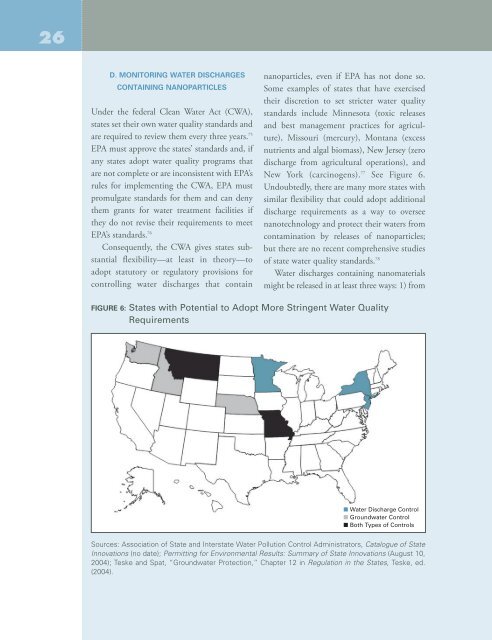ROOM AT THE BOTTOM? - Project on Emerging Nanotechnologies
ROOM AT THE BOTTOM? - Project on Emerging Nanotechnologies
ROOM AT THE BOTTOM? - Project on Emerging Nanotechnologies
Create successful ePaper yourself
Turn your PDF publications into a flip-book with our unique Google optimized e-Paper software.
26<br />
D. MONITORING W<str<strong>on</strong>g>AT</str<strong>on</strong>g>ER DISCHARGES<br />
CONTAINING NANOPARTICLES<br />
Under the federal Clean Water Act (CWA),<br />
states set their own water quality standards and<br />
are required to review them every three years. 75<br />
EPA must approve the states’ standards and, if<br />
any states adopt water quality programs that<br />
are not complete or are inc<strong>on</strong>sistent with EPA’s<br />
rules for implementing the CWA, EPA must<br />
promulgate standards for them and can deny<br />
them grants for water treatment facilities if<br />
they do not revise their requirements to meet<br />
EPA’s standards. 76<br />
C<strong>on</strong>sequently, the CWA gives states substantial<br />
flexibility—at least in theory—to<br />
adopt statutory or regulatory provisi<strong>on</strong>s for<br />
c<strong>on</strong>trolling water discharges that c<strong>on</strong>tain<br />
nanoparticles, even if EPA has not d<strong>on</strong>e so.<br />
Some examples of states that have exercised<br />
their discreti<strong>on</strong> to set stricter water quality<br />
standards include Minnesota (toxic releases<br />
and best management practices for agriculture),<br />
Missouri (mercury), M<strong>on</strong>tana (excess<br />
nutrients and algal biomass), New Jersey (zero<br />
discharge from agricultural operati<strong>on</strong>s), and<br />
New York (carcinogens). 77 See Figure 6.<br />
Undoubtedly, there are many more states with<br />
similar flexibility that could adopt additi<strong>on</strong>al<br />
discharge requirements as a way to oversee<br />
nanotechnology and protect their waters from<br />
c<strong>on</strong>taminati<strong>on</strong> by releases of nanoparticles;<br />
but there are no recent comprehensive studies<br />
of state water quality standards. 78<br />
Water discharges c<strong>on</strong>taining nanomaterials<br />
might be released in at least three ways: 1) from<br />
FIGURE 6: States with Potential to Adopt More Stringent Water Quality<br />
Requirements<br />
■ Water Discharge C<strong>on</strong>trol<br />
■ Groundwater C<strong>on</strong>trol<br />
■ Both Types of C<strong>on</strong>trols<br />
Sources: Associati<strong>on</strong> of State and Interstate Water Polluti<strong>on</strong> C<strong>on</strong>trol Administrators, Catalogue of State<br />
Innovati<strong>on</strong>s (no date); Permitting for Envir<strong>on</strong>mental Results: Summary of State Innovati<strong>on</strong>s (August 10,<br />
2004); Teske and Spat, “Groundwater Protecti<strong>on</strong>,” Chapter 12 in Regulati<strong>on</strong> in the States, Teske, ed.<br />
(2004).
















